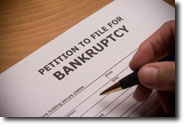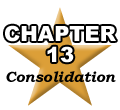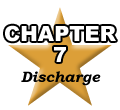
Federal Law provides a method by which persons, burdened by excessive debt, can obtain a fresh financial start and pursue newly productive lives unimpaired by past financial problems. It is an important alternative for persons mired deep in financial difficulty.
The Federal bankruptcy laws were enacted to provide debtors with a fresh start and to establish a ranking among creditors who are clamoring for a debtor’s limited resources. Bankruptcy helps people avoid the kind of permanent discouragement that can prevent them from ever reestablishing themselves as hard-working members of society.
Bankruptcy is a legal petition that declares your inability to pay your creditors. You have rights according to bankruptcy laws whereby you may file for bankruptcy. Generally, a debtor declares bankruptcy to obtain relief from debt, and this is accomplished either through a discharge of the debt or through a restructuring of the debt.
There are generally two types of consumer bankruptcy; Chapter 7 and Chapter 13.
The Bankruptcy Code (Title 11, U. S. Code) is divided into chapters. The chapters which usually apply to consumer debtors are Chapter 13 (consolidation plan or repayment plan), and Chapter 7 (liquidation).
Chapter 13 is referred to as “debt consolidation” or “repayment plan”. It offers a payment plan for individuals with a regular source of income. With Chapter 13, you can consolidate all your bills into one monthly payment. This payment is determined by your “projected disposable income,” which is the amount of your income, less your reasonable monthly living expenses.

With Chapter 13, the debtor files a Chapter 13 plan proposing to pay creditors monthly for a period of 36 to 60 months. The debtor files a bankruptcy petition and schedules which list all assets and all debts. Upon filing, a debtor receives an automatic stay order prohibiting creditors from taking any action against the debtor. A debtor may catch up on secured debts such as car payments or home mortgage payments through the Chapter 13 plan. Priority creditors such as taxes are paid through the plan. Unsecured creditors (loan companies, credit cards, medical bills, etc.), are paid last in the plan and normally receive a percentage of what is owed to them, and in many cases very little or nothing. At the end of the plan term, the Court grants a discharge order eliminating any remaining dischargeable debts, except for long term debts such a house notes. A debtor keeps all property in a Chapter 13 (and so does not lose property that would have been lost in a Chapter 7). Also the debtor’s legal fees may be included in the Chapter 13 plan, so such a case may be filed for less money in advance than a Chapter 7.

Chapter 7 is referred to as a “liquidation” or “straight bankruptcy.” With Chapter 7, you can secure a fresh start.
In Chapter 7, the debtor requests that the Court grant a discharge order legally eliminating debts. The debtor files a bankruptcy petition and schedules that list all assets and all debts. Upon filing, the debtor receives an automatic stay order prohibiting creditors from taking any action against the debtor. The debtor keeps all exempt assets (i.e. most household goods, clothing, earned income credit, one vehicle up to a value of $7,500.00, etc.) However, the debtor may lose non-exempt property, which is sold off by the trustee to pay debts (i.e. money, heir property, tax refunds other than earned income credit, damage claims, extra vehicles, etc.). Certain debts are non-dischargeable (student loans, some taxes, domestic support obligations, etc.) Chapter 7 generally does not assist debtors with past due car or home mortgage payments.